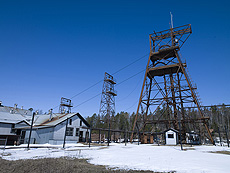Update on CDMS and MINOS
 |
| The head frame of the Soudan Underground Mine in April 2009. Photo: Reidar Hahn, Fermilab |
Scientists are making progress with their assessment of the status of the CDMS and MINOS experiments in the Soudan Underground Laboratory, following a fire on March 17 in the access shaft of the Soudan mine. But power is still out in the MINOS cavern due to a damaged power feed into the laboratory.
Scientists inspected the MINOS detector on Wednesday. They found residue of fire-fighting foam, used to extinguish the fire in the shaft, across large parts of the MINOS cavern’s floor. No water or foam got on the connectors of the MINOS experiments’ electronics, but scientists discovered that they need to dry out the lowest part of the experiment’s large electromagnetic coil, which provides the experiment with a magnetic field for particle identification. A part of the coil runs through a shallow trench, which partially filled with water. The inspection of other parts of the experiment is ongoing.
“There are still some unknowns, and we don’t know how long it will take for the laboratory to be fully functional again,” said Rob Plunkett, co-spokesperson for the MINOS experiment. “The good news is that there seems to be very little damage to the experiments.”
CDMS scientists have had limited power to their experiment since Monday, March 28 (see this earlier update).They have found no problems with their particle detector. All cryogenic systems work as designed, and scientists expect the rest of the equipment to be fine, too.
Cleanup work and repairs continue in the access shaft of the mine. When complete, electricians will install a new power cable between the mine’s level 22 and the underground laboratory, which is located on level 27. The new cable is necessary to restore full power to the laboratory.
-- Kurt Riesselmann
|